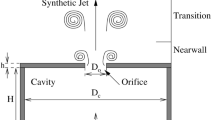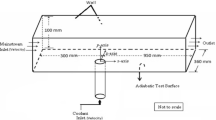Abstract
In this research, three-parameter numerical optimization of aerodynamic characteristics of an airfoil at high angle of attack is carried out. The separation region is reduced with two types of suction/blowing usage: single blowing function jet and combined suction and blowing jets. Genetic algorithm is used to optimize the three parameters of the suction/blowing jet strength, jet angle and jet location. The objective of this investigation was to reduce the high separation region over the NACA0012 airfoil to enhance its aerodynamic characteristics. The time-averaged compressible Navier–Stokes equations with Spalart–Allmaras turbulence model are solved along with optimization algorithm. The lift-to-drag ratio is increased up to 80 % with respect to the uncontrolled flow field.
Similar content being viewed by others
Abbreviations
- \(\rho \) :
-
Mass density
- u, v :
-
Mean velocity components
- \(q_{x},q_{y}\) :
-
Heat flux components
- \(\tau _{ij}\) :
-
Viscous stress
- \(\tau _{{\mathrm{t}_{ij}}}\) :
-
Turbulence viscous stress
- E :
-
Total energy per unit volume
- p :
-
Pressure
- k :
-
Thermal conductivity
- \(\mu \) :
-
Viscosity
- \(\mu _\mathrm{t}\) :
-
Turbulent viscosity
- T :
-
Temperature
- e :
-
Specific internal energy
- \(\gamma \) :
-
Rate of the specific heat
- \(c_\mathrm{v}\) :
-
Specific heat at constant volumes
- \(c_\mathrm{p}\) :
-
Specific heat at constant pressure
- \(\alpha \) :
-
Angle of attack
- V :
-
Jet velocity
- \(\theta \) :
-
Jet angle with respect to the horizon
- \(L_{\mathrm{j}}\) :
-
Jet location
- \(C_{{\mathrm{d}_\mathrm{B}}}\) :
-
Drag coefficient of the base airfoil
- \(C_{{\mathrm{l}_\mathrm{B}}}\) :
-
Lift coefficient of the base airfoil
- M :
-
Mach number
References
DeMauro, E.P.; Haley, D.; Sarah, Z.; Chia Min L.; Michael A.: Control of laminar separation bubble on NACA 0009 airfoil using electroactive polymers. AIAA J. 53(8), 2270–2279 (2015)
Kato, K.; Breitsamter, C.: Flow control on Gö 387 airfoil by using nanosecond pulse plasma actuator. In: Theofilis, V., Soria, J. (eds.) Instability and Control of Massively Separated Flows, pp. 65–70. Springer, Berlin (2015)
Wild, J.: Mach-, Reynolds-and Sweep effects on active flow separation control effectivity on a 2-element airfoil wing. In: King, R. (ed.) Active Flow and Combustion Control 2014, pp. 87–100. Springer, Berlin (2015)
Seifert, A.; Pack, L.G.: Separation Control at Flight Reynolds Numbers: Lessons Learned and Future Directions. AIAA paper 2000–2542 (2000)
Seifert, A.; Pack, L.G.: Active flow separation control on wall-mounted hump at high Reynolds numbers. AIAA J. 40(7), 1363–1372 (2002)
Pack, L.G.; Seifert, A.: Periodic excitation for jet vectoring and enhanced spreading. J. Aircr. 38(3), 486–495 (2001)
Frunzulică, F.; Dumitrache, A.; Dumitrescu, H.: Investigations of passive flow control devices for vertical axis wind turbines. PAMM 14(1), 723–724 (2014)
Lovig, E.N.; Downs, R.S.; White, E.B.: Passive laminar flow control at low turbulence levels. AIAA J. 52(5), 1072–1075 (2014)
Wang, J.; Bartow,W.; Moreyra, A.; Woyczynski, G.; Lefebvre, A.; Carrington, E.; Zha, G.: Low drag automotive mirrors using passive jet flow control. SAE Int. J. Passenger Cars Mech. Syst. 7, 538–549 (2014).
Gul, M.; Uzol, O.; Akmandor, I.: An experimental study on active flow control using synthetic jet actuators over S809 airfoil. J. Phys. Conf. Ser. 524(1), 012101 (2014)
Asada, K.; et al.: LES on turbulent separated flow around NACA0015 at Reynolds number 1,600,000 toward active flow Control. In: AIAA conference AVIATION (2014)
Jones, G.; Santer, M.; Papadakis, G.; Bouremel, Y.; Debiasi, M.; Imperial-NUS Joint PhD Collaboration: Flow control at low Reynolds numbers using periodic airfoil morphing. In: APS Meeting Abstracts. 67th Annual Meeting of the APS Division of Fluid Dynamics, vol. 59, Number 20, San Francisco, California (2014)
Gad-el-Hak, M.; Bushnell, D.M.: Separation control: review. J. Fluids Eng. 113(1), 5–30 (1991)
Stanewsky, E.: Adaptive wing and flow control technology. Prog. Aerosp. Sci. 37(7), 583–667 (2001)
Ashill, P.; Fulker, J.; Hackett, K.: A review of recent developments in flow control. Aeronaut. J. 2005(109), 205–232 (1095)
Huang, L.; et al.: Optimization of blowing and suction control on NACA 0012 airfoil using earned genetic algorithm with diversity control. J. Aircr. 44(4), 1337–1349 (2006)
Favier, J.; Kourta, A.; Leplat, G.: Control of flow separation on a wing profile using PIV measurements and POD analysis. In: Morrison, J.F., Birch, D.M., Lavoie, P. (eds.) IUTAM Symposium on Flow Control and MEMS. Springer, Berlin (2008)
Beliganur, N.K.; Raymond, P.: Application of Evolutionary Algorithms to Flow Control Optimization. Report of University of Kentuchky (2007)
Lee, J.; Jung, K.; Kwon, J.H.: The aerodynamic shape optimization of airfoils using unconstrained trust region methods. Eng. Optim. 41(5), 459–471 (2009)
Zhang, F.; Chen, S.; Khalid, M.: Optimization of transonic wing with fuselage by real-coded genetic algorithm. In: 10th AIAA/ISSMO Multidisciplinary Analysis and Optimisation Conference (2004)
Manan, A.; et al.: Optimization of aeroelastic composite structures using evolutionary algorithms. Eng. Optim. 42(2), 171–184 (2010)
Marta, A.C.: Parametric Study of a Genetic Algorithm Using a Aircraft Design Optimization Problem. Report Stanford University, Department of Aeronautics and Astronautics (2008)
Liu, J.-L.: Intelligent genetic algorithm and its application to aerodynamic optimization of airplanes. AIAA J. 43(3), 530–538 (2005)
Shimizu, T.: An extension to Roe’s scheme for gas dynamics: general equations of state and spherical coordinates. RIKEN Rev. pp. 27–28 (1996)
Gregory, N.; O’reilly, C.: Low-Speed aerodynamic characteristics of NACA 0012 aerofoil section,including the effects of upper-surface roughness simulating hoar frost. HM Stationery Office, London (1973)
Author information
Authors and Affiliations
Corresponding author
Rights and permissions
About this article
Cite this article
Farhadi, A., Rad, E.G. & Emdad, H. Aerodynamic Multi-Parameter Optimization of NACA0012 Airfoil Using Suction/Blowing Jet Technique. Arab J Sci Eng 42, 1727–1735 (2017). https://doi.org/10.1007/s13369-016-2259-3
Received:
Accepted:
Published:
Issue Date:
DOI: https://doi.org/10.1007/s13369-016-2259-3




